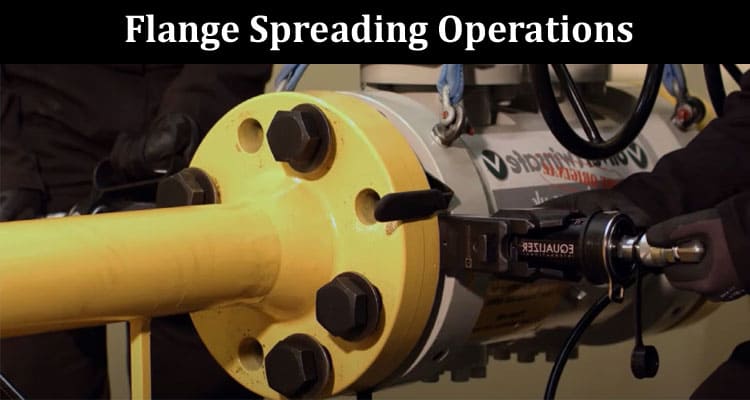In the intricate and often hazardous world of industrial maintenance, the task of flange spreading stands out for its critical need for safety and precision. This process, essential in the maintenance and operation of pipelines and machinery, involves separating flange joints – a task that, if not executed with the utmost care, can lead to severe workplace accidents. In this article, we delve into the best practices for mitigating risks associated with flange spreaders, drawing on expert insights and industry-leading advice.
Understanding Flange Spreaders and Safety
Flange spreaders, or flange separators as they are sometimes known, are specialised tools designed for the safe and efficient separation of flange joints. These tools are indispensable in various industrial applications, from pipeline maintenance to machinery repair. However, their operation is not without risks, and understanding these risks is the first step towards mitigating them.
Types and Mechanics of Flange Spreaders
Flange spreaders come in various forms, each suited to specific tasks and flange types. The most common are mechanical, hydraulic, and pneumatic flange spreaders. Mechanical spreaders are manually operated and are ideal for smaller, less demanding tasks. Hydraulic spreaders, on the other hand, use hydraulic power to exert force and are suitable for heavy-duty operations. Pneumatic spreaders, utilising compressed air, offer a balance of power and portability.
The mechanics of these tools involve applying force to create a gap between the flanges. This force must be controlled and evenly distributed to prevent damage to the flanges and ensure the safety of the operator. An uneven application of force can lead to the flanges snapping shut unexpectedly, posing a significant risk to workers.
The Role of Safety Blocks
A crucial component in the safe operation of flange spreaders is the use of safety blocks, also known as solid blocks. Once the flanges have been separated, safety blocks are inserted between them to prevent accidental closure. These blocks are not only a safety measure but also enhance the efficiency of the operation by reducing the need for repositioning and multiple passes.
Mitigating Risks in Flange Spreading
Proper Use and Maintenance
The safe operation of flange spreaders hinges on their proper use and maintenance. This includes understanding the correct positioning of the spreader, applying the right amount of force, and utilising safety blocks effectively. Regular inspection of the tool for signs of wear or damage is crucial, as is proper storage to prevent rust or corrosion. Adherence to the manufacturer’s instructions for use and maintenance not only prolongs the life of the tool but also safeguards the operator.
Importance of Worker Training
No amount of sophisticated equipment can substitute for well-trained personnel. Workers must be thoroughly trained in the correct use of flange spreaders, the risks involved, and the methods to mitigate these risks. This training should cover the positioning of the spreader, the application of force, the use of safety blocks, and the importance of personal protective equipment (PPE). A well-trained workforce is not only more efficient but also safer, significantly reducing the likelihood of accidents and injuries.
Key Safety Insights for Flange Spreading Operations
The safe operation of flange spreaders is not just about following a set of instructions; it’s about understanding the nuances of the task at hand and applying best practices gleaned from industry experts. Let’s explore some key safety insights that are essential for mitigating risks in flange spreading operations.
Controlled Force Application and Stability
One of the most critical aspects of using flange spreaders, especially hydraulic types, is the controlled application of force. It’s imperative to apply force in a gradual and steady manner to avoid sudden movements that could destabilise the flanges. Stability during the spreading process is crucial to prevent the flanges from snapping shut unexpectedly, which could lead to serious injuries. Ensuring that the spreader remains securely in place throughout the operation is a vital safety measure.
Proper Alignment and Safety Wedges
Proper alignment of the flange spreader is another key factor in safe operation. Misalignment can lead to uneven force distribution, increasing the risk of accidents. Using alignment tools, such as flange alignment pins, can significantly reduce this risk by ensuring that the spreader is positioned correctly.
In addition to alignment, the use of safety wedges plays a vital role in preventing the flanges from closing. These wedges, often made of materials like brass or steel, are designed to absorb shock and restrain the flanges, providing an additional layer of safety. They should be inserted once the desired gap is achieved to maintain separation and protect workers.
Comprehensive Safety Features in Flange Spreaders
When selecting flange spreaders, it’s essential to consider models that incorporate comprehensive safety features. This includes features like strong gripping power, which prevents the spreader from dislodging during operation, and the ability to maintain parallel separation, which is crucial for the even distribution of force. Spreaders that can achieve the desired gap in fewer passes are preferable, as they reduce the time workers are exposed to potential hazards.
Conclusion
Safety in flange spreading operations is not a matter to be taken lightly. It requires a combination of the right tools, proper techniques, and well-trained personnel. By applying controlled force, ensuring proper alignment, using safety wedges, and choosing spreaders with comprehensive safety features, the risks associated with flange spreading can be significantly mitigated.
As we continue to advance in industrial maintenance and operations, the emphasis on safety must remain paramount. The insights and practices discussed here are not just guidelines; they are essential components of a culture of safety that should be ingrained in every aspect of industrial work. By prioritizing safety, we not only protect workers but also enhance the efficiency and reliability of our operations, ensuring a safer and more productive industrial environment.


